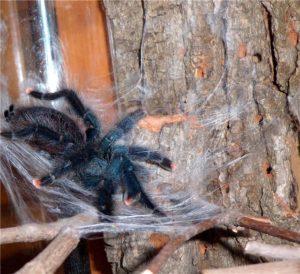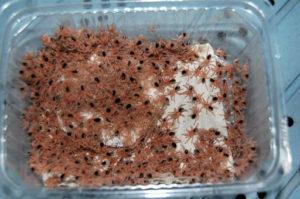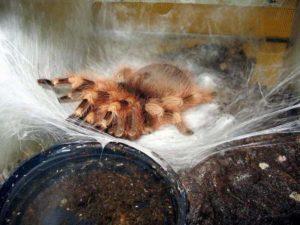Spiders tarantulas: cute and awesome
Large spiders cause at least hostility, and sometimes panic fear. They really look intimidating, especially tarantulas, which are one of the largest representatives of their kind.
Content
What does a tarantula look like: photo
Description of spiders
Name: Tarantulas or Tarantulas
Latin: TheraphosidaeClass: Arachnida - Arachnida
Squad: Spiders - Araneae
 | Habitats: | trees, grass, burrows |
 | Dangerous for: | small insects |
 | Attitude towards people: | bites, many are poisonous. |
Tarantulas actually got this name undeservedly. They may feed on birds, but very rarely. This name was obtained due to the work of one of the researchers, who caught the process of eating a hummingbird by a spider.
Appearance
The tarantula looks really intimidating and at the same time very rich. Dimensions in the span of the legs can reach 20-30 cm. Almost all individuals are covered with thick hairs, which often differ in shade from the calf itself.
The shades of the spider depend on the species and lifestyle. Exist:
- brown-black;
- taupe;
- beige-brown;
- pinkish;
- blue;
- black;
- redheads;
- orange.
Habitat and distribution
Most of all, tarantulas love the conditions of the subtropics and tropics. Although they are found in arid semi-deserts or in tropical forests. But different individuals are distributed everywhere, in addition to Antarctica.
Inhabit:
- Africa;
- South America;
- Australia;
- Oceania;
- Central Asia;
- part of Europe.
Hunting and food
Tarantulas ambush their prey. They do not weave a web for hunting, but attack from an ambush. These species feed only on insects and small arachnids.
Spiders do not show excessive activity. Simply put, once again they prefer not to move. All free time, when the spider is full, he spends in his habitat:
- in the crown of trees;
- on the branches of shrubs;
- in holes;
- on the ground surface.
The lifestyle of a spider can change. Often, tarantulas spend their childhood in burrows or nests of rodents, which they make their own. And adults can come to the surface or even climb trees.
Life cycle
Spiders are long-lived among representatives of their kind. There are record holders, females that live for about 30 years in conditions of adequate nutrition.
Males are completely opposite, live for several years. If they do not mate, then when they reach puberty they do not molt, they quickly die.
There are tarantulas from eggs, newborns are called nymphs. They live together before they turn into larvae, which is about 2 molts.
Molting is the process of shedding the exoskeleton. Such a procedure is like a new stage in the life of a spider, even the life span is measured by the number of molts. Just between them, the size of the spider's body increases.
In young individuals, the molting process takes place every month, and adults change the skeleton once a year on average.
It's pretty easy to understand that a tarantula is preparing for skin changes. The abdomen darkens, the spider refuses to eat, just before that they turn over on their back.
Gradually, the spider begins to stretch the cephalothorax, the membrane of the abdomen is torn. Slowly, the spider begins to reach out for limbs.
Sometimes one or more of the spider's legs become clogged in the old exuvia. Then the tarantula discards them, they grow back in the next few procedures.
Reproduction
Males become sexually mature earlier than females. They have containers on the pedipalps in which the seminal fluid matures.
When the male finds a suitable partner, he begins a whole ritual, a mating dance. He cautiously approaches and conducts mating. After that, the spider man quickly takes off his legs so that the aggressive lady does not eat him.
The female lays a cocoon in 1,5-2 months. It can contain up to 2000 eggs. She incubates the offspring by turning it over periodically and protecting it from various predators.
Protective mechanism
Spiders are aggressive predators. Wow poison is toxic and dangerous. There is no data on a fatal outcome when a person is bitten by a tarantula, but young children and allergy sufferers definitely need to be careful.
There are no non-poisonous representatives of the species. There are only those whose poison has an average toxicity.
The tarantula is protected from danger in two ways:
Bite:
- causes itching;
- heat;
- convulsions.
Hairs:
- itching;
- weakness;
- suffocation.
There are species of tarantulas that use their own excrement for self-defense. They throw them at the enemy.
Breeding tarantulas at home
Tarantulas are one of the trendy exotic pets these days. They are unpretentious and simply adapt to limited living conditions.
There are only a few requirements breeding tarantulas.
Terrarium
The spider's place of residence should be comfortable. He is planted in terrariums that are not cramped, but not large either. Grow only one animal, because they are prone to cannibalism.
The container should contain coconut substrate, a small shelter in the form of a piece of clay pot or driftwood. Be sure to have a lid, because the tarantula easily slides on the glass.
Food
At home, spiders are fed with food that is available to him in nature. The size of the food should not exceed the body size of the tarantula. It is undesirable to feed them with meat. Suitable cockroaches, crickets, mealybugs and small insects.
Be careful with the way food is served. It is served with long tweezers. The bait is left in plain sight to lure the spider's eye, but also leave him an opportunity to hunt.
You can choose a tarantula for breeding at home using material in the article.
Socialization
Tarantulas are very different in character depending on the type of spider. But all of them are not prone to socialization and are not amenable to training. All individuals at the first danger rush to the attack.
Spiders are best avoided. Hairs are also irritants. Perhaps only the relative calm of those individuals that from childhood were taken into the hands of people. But this is not training, but simply a dulling of the reaction to an irritant in the form of people.
There have been cases that pets, cats and dogs have died from the bites of domestic tarantula spiders.
Conclusion
Tarantulas are one of the large, fearsome predators. They inspire respect with their appearance and size. The nature of these animals is aggressive and dangerous.
But with a person they try to minimize contact and avoid meeting. The bite carries a lot of discomfort and can be fraught with consequences, especially for allergy sufferers.
Previous



Meni su tarantule preslathe ne bojim ih je samo nevolim tarantula sa dugačkim nogama.